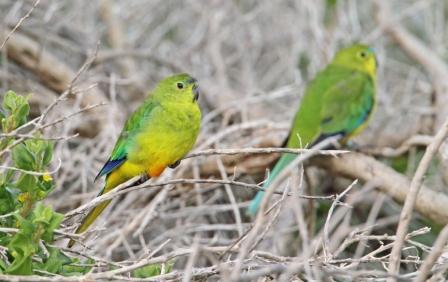 Orange-bellied Parrots by Chris TzarosWith a wild population of less than 50, it’s not surprising that the location of a summer hide-out used by a mysterious male Orange-bellied Parrot (Neophema chrysogaster) is of great interest to the team trying to save the species from extinction.
Orange-bellied Parrots by Chris TzarosWith a wild population of less than 50, it’s not surprising that the location of a summer hide-out used by a mysterious male Orange-bellied Parrot (Neophema chrysogaster) is of great interest to the team trying to save the species from extinction.
In its 2012 update, the Orange-bellied Parrot recovery team has revealed that an eight year old male bird, seen during Winter around Victoria’s Port Phillip Bay, has not been seen for several seasons at the only known breeding site for the species at Melaleuca on Tasmania’s west coast.
Recovery Team member Peter Menkhorst, from the Department of Sustainability and Environment’s (DSE) Arthur Rylah Institute (ARI) said: “We have been aware of this bird since he was banded as a juvenile at Melaleuca in the summer of 2004/05 and he has been seen in Victoria over several winters, but we still don’t know where he goes during the breeding season.”
“With such small numbers in the wild it is of great interest to the recovery team to find out if there is another, previously unknown, site where this species breeds,” Mr Menkhorst said.
“Unfortunately, no matter where he is going, we know from the small numbers coming to the winter feeding grounds in Victoria and South Australia that there is no large undiscovered breeding population of these birds.”
“The other news during the 2012 breeding season was encouraging, with all known adult females participating in breeding at Melaleuca and at least 14 young fledging. The team decided it wasn’t necessary for any more wild birds to be taken into captivity this year as part of the Captive Breeding program.”
“The successful captive breeding program, based at Healesville Sanctuary in Victoria, as well as at other facilities in Tasmania, NSW and South Australia, now has more than 200 birds and the team is considering the possibility of a release of captive-bred birds in the near future.”
The Orange-bellied Parrot National Recovery Team consists of representatives of the Commonwealth, Victorian, Tasmanian and South Australian governments, Zoos Victoria, Adelaide Zoo, Birdlife Australia, the Tasmanian Conservation Trust and threatened species experts.
This work has historically been funded by the Australian Government's Caring for our Country (CFOC) program, and the Victorian Government's Victorian Investment Framework (VIF) in partnership with the Corangamite and Glenelg Hopkins Catchment Management Authorities. The current investment is by VIF. The Corangamite and Glenelg Hopkins CMAs provide a total of $60,000. VIF and CfoC have funded a Salt Marsh habitat conservation management across four CMAs. Corangamite CMA is coordinating this project and has received a million dollars from the Commonwealth and Victorian Governments.
The Victorian Government has a responsibility under the Wildlife Act 1975 and the Flora and Fauna Guarantee Act to protect threatened species. These animals and plants contribute significantly to the biodiversity of their ecosystems. The knowledge we acquire about these species helps us to then take the on-ground steps needed to ensure their survival.